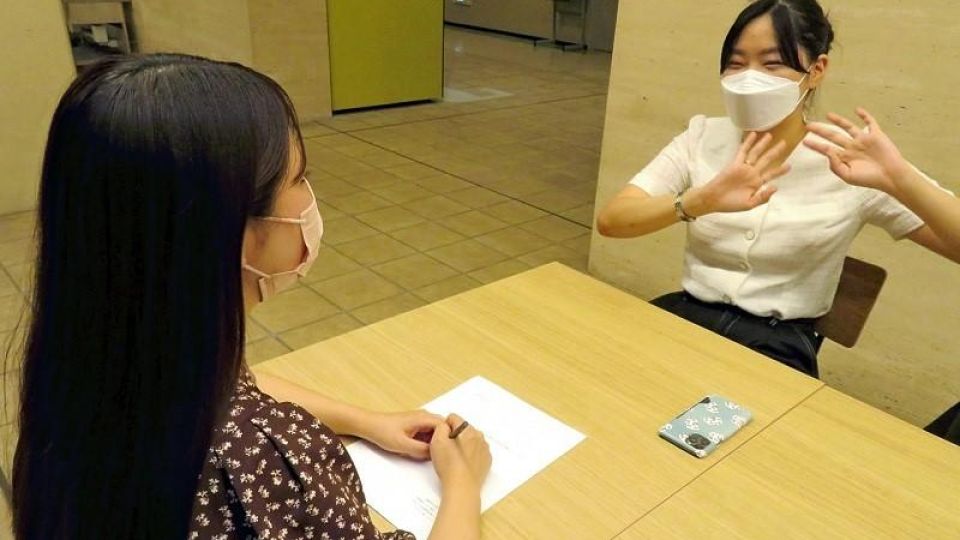August 30, 2022
TOKYO – Many foreign students have returned to their Japanese universities for the first time in two years, bringing campuses back to a level of energy last seen before the novel coronavirus pandemic.
Pandemic-related restrictions on the entry of foreigners began to be relaxed in March, and about 115,000 foreign students had entered Japan as of the end of July.
Universities have also been making their lectures more international.
One university, for example, has asked professors at overseas institutions to give lectures online, drawing on experience with online classes that was acquired during the coronavirus crisis.
Stuck for 2 years
In mid-July, a South Korean and a Japanese student at Tokyo University of Foreign Studies chatted about cultural differences between their two countries.
“In South Korea, we often call regular friends by their first name and very close friends by their full name,” said Kim Yu-bin, 21, a third-year student of the university’s School of Japan Studies.
Keito Mori, 20, replied: “It’s the opposite in Japan. Do you call anybody by just their family name?” Mori is also a third-year student and majors in Korean language.
Kim replied, “In South Korea, that can feel very rude.”
Japanese TV dramas and manga prompted Kim’s interest in Japan, and she did short home stays in Akita Prefecture when she was in junior and senior high school. She enrolled in Tokyo University of Foreign Studies in spring 2020, and even considered the idea of working in Japan someday.
But she was unable to come to Japan due to the coronavirus pandemic and could only listen to online lectures at home.
Kim was finally able to enter Japan in March. “I’m glad to communicate with Japanese people in person,” she said.
Mori also said with a smile, “It’s fun to hear things about cultures and customs that are not taught in the lectures.”
Tokyo University of Foreign Studies had 229 foreign students on a waiting list to enter Japan as of March 1 this year, but now that number has fallen to zero.
Utilizing online classes
Remote lectures using online teleconference systems proliferated worldwide during the pandemic, and universities in Japan also rapidly globalized their lectures.
Kindai University in Osaka Prefecture holds lectures in which students and teaching staff at foreign universities are invited to join online.
Prof. Yoshihiro Omura of the university’s Faculty of International Studies invited a U.S. university staffer who specializes in sign language to give a lecture in English as part of his language studies seminar.
In the university’s Faculty of Economics, students hold discussions in English with students in Germany about international business affairs.
“The importance of studying abroad, during which students spend time in a foreign environment all day long, has not changed,” Omura said.
However, he said, “online lectures in which students can listen to experts overseas while staying in Japan are also popular. This option will remain in place even after the coronavirus crisis ends.”
Ritsumeikan Asia Pacific University in Oita Prefecture holds online lectures allowing students, for example, to hear lectures by teachers at a Swedish university.
“Online classes let regional universities provide lectures with internationalized content equal to that of universities in urban areas,” a spokesperson for the university said.
Tokyo University of Foreign Studies is offering an increasing number of guest lectures by professors and teaching staff at foreign universities. For example, a professor at Rio de Janeiro State University has given online lectures about Portuguese literature.
International programs
International programs that were in place before the start of the novel coronavirus pandemic are also being increasingly revived and the number of participants is growing.
Kansai University has conducted a program named Collaborative Online International Learning (COIL), in which it connects with foreign universities online, from fiscal 2014.
A total of 1,283 people attended lectures under the program in 34 subjects in fiscal 2019. This number rose to 1,632 people in 45 subjects in fiscal 2021.
Many of the lectures initially covered humanities, but the program has since spread to the natural sciences as well. For example, classes comparing medical equipment in Japan and the United States are held for its Faculty of Chemistry, Materials and Bioengineering.
“Online classes are suitable for working adults whose spare time is limited. We want to expand the program,” a university official said.
Sophia University in Tokyo also introduced the COIL program in fiscal 2018.
Compared with fiscal 2019, before the start of the novel coronavirus pandemic, the number of classes under the program had approximately tripled in fiscal 2021.
Aiming for recovery by 2027
As Japan reopened its doors to foreign students later than other countries, some potential students instead went to South Korea or elsewhere.
The number of foreign students in Japan was about 312,000 in May 2019, but this fell to about 242,000 in May 2021.
The government decided to resume accepting foreign students in March this year. It also established a system to accept foreign students separately from its quotas on other foreign nationals who want to enter Japan.
By the end of July, a total of 115,155 foreign nationals had entered Japan with student visas.
The Education, Culture, Sports, Science and Technology Ministry aims to restore the number of foreign students to the pre-pandemic level by 2027.
The government plans to revise its basic policy on accepting foreign students, and will consider increasing the number to be accepted in scientific fields and from European countries.

